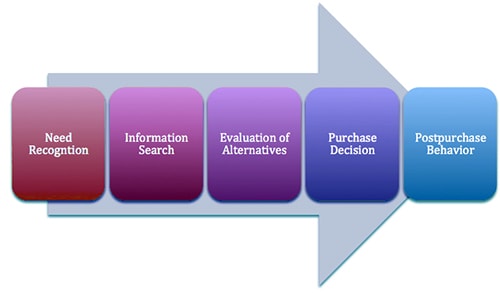The customer buying process (also called a buying decision process) describes the journey customer goes through before they buy the product.
A buying process the s the series of steps that a consumer will take to make a purchasing decision. A standard model of consumer purchase decision-making includes recognition of needs and wants, information search, evaluation of choices, purchase, and post-purchase evaluation.

Need recognition
This is often identified as the first and most important step in the customer’s decision process. A purchase cannot take place without the recognition of the need. The need may have been triggered by internal stimuli (such as hunger or thirst) or external stimuli (such as advertising or word of mouth).
Information search
The interested consumer will try to seek information. Now. he will read newspapers and magazines, watch television, visit showroom or dealer. contact salesman, discuss with friends and relatives. and try all the possible sources of information.Mostly, the consumer can try one or more of following sources of information:
- Personal Sources: They may include family members, friends, package, colleagues, and relatives.
- Commercial Sources: Advertising, salesmen, dealers, package, trade show, display, and exhibition are dominant commercial sources.
- Public Sources: Mass media (radio. TV. newspapers. magazines. cinema, etc.). consumer- rating agencies. etc.. are main public sources.
- Experimental Sources: They include handling, examining. testing. or using the product. Selection of sources depends upon personal characteristics, types of products, and capacity and reliability of sources.
Evaluation of alternatives
In the former stage. the consumer has collected information about certain brands. Now, he undergoes evaluation of brands. He cannot buy all of them. Normally. he selects the, best one. the brand that offers maximum satisfaction. Here. he evaluates competitive brands to judge which one is the best, the most attractive. Evaluation calls for evaluating various alternatives with certain choice criteria
Following criteria are considered while evaluating alternatives:
- Benefits offered by the brands
- Qualities, features or attributes, and performance
- Price changed by various brands
- History of brands
- Popularity, image or reputation of brands
- Product-related services offered by the brands. such as after-sales services and free installation
- Availability of brands and dealer rating.
Purchase decision
The penultimate stage is where the purchase takes place. Philip Kotler (2009) states that the final purchase decision may be ‘disrupted’ by two factors: negative feedback from other customers and the level of motivation to accept the feedback. For example. having gone through the previous three stages, a customer chooses to buy a new telescope. However, because of his very good friend, a keen astronomer, gives him negative feedback, he will then be bound to change his preference. Furthermore, the decision may be disrupted due to unforeseen situations such as a sudden.
job loss or relocation. Sub-decisions in Purchase Decision:
Consumer’s buying decision involves following five sub-decisions:
- Brand Decision: For example, CBZ (model) motorbike of Hero Honda.
- Vendor Decision: For example. XYZ Hero Honda Showroom.
- Quantity Decision: For example, one motorbike.
- Timing Decision: For example, on Is‘ December 2007.
- Payment Decision: For example, by cash.













